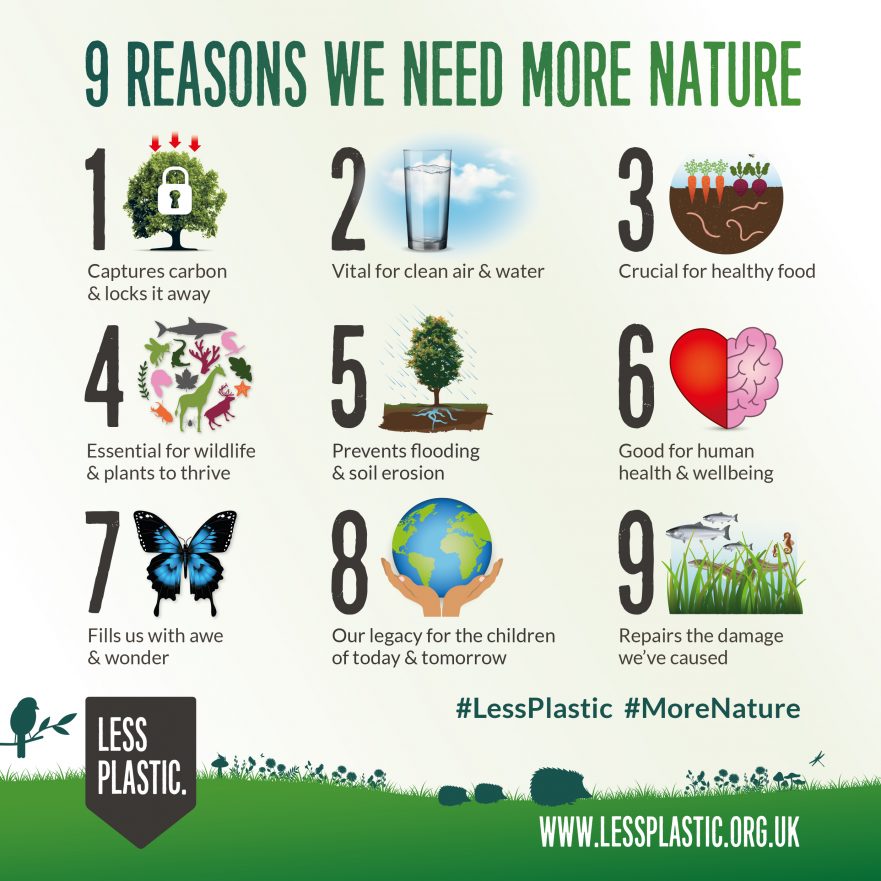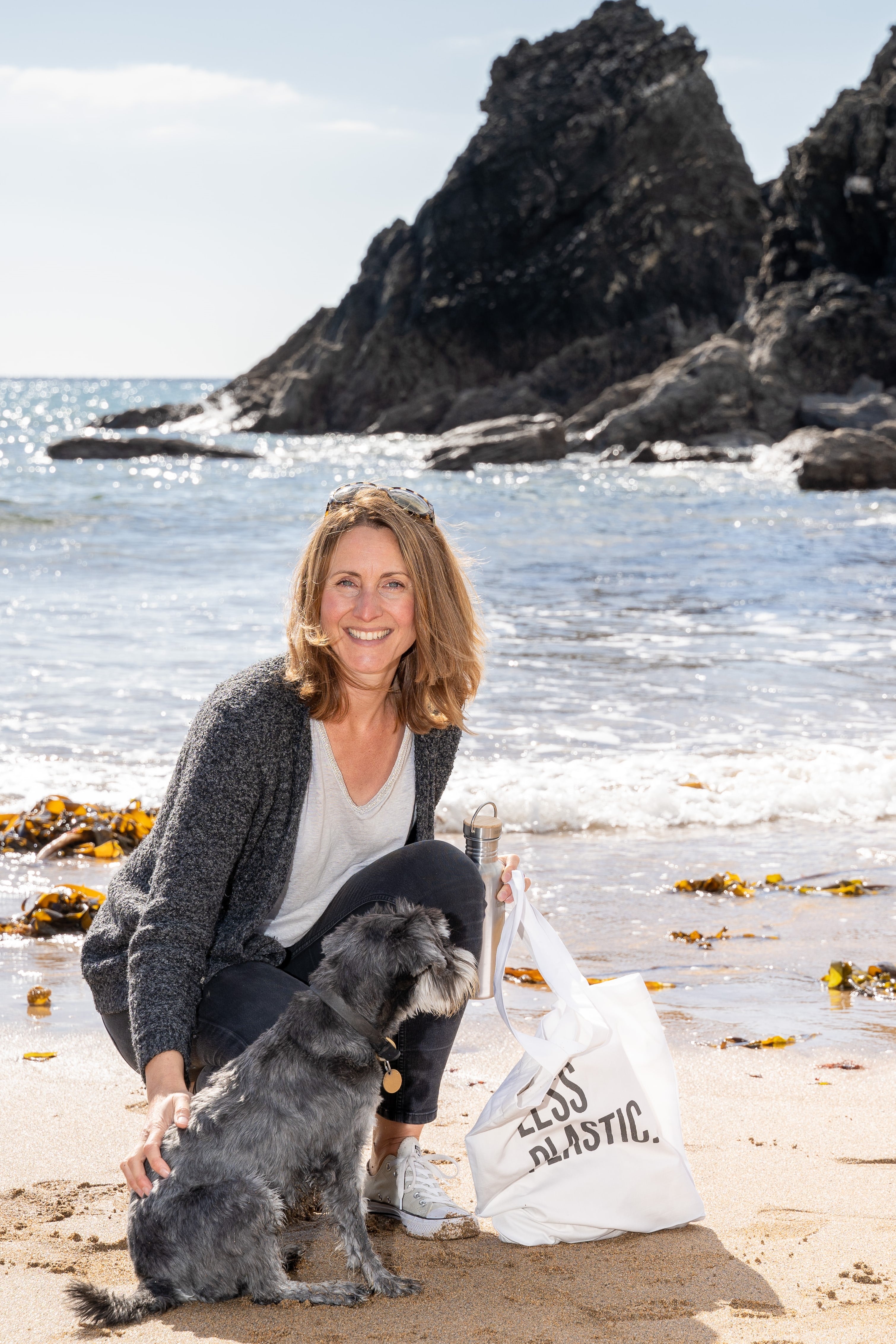Share this Post
Our #LessPlastic #MoreNature infographics are designed to highlight simple ways we can ALL get involved in regenerating nature – whether as individuals, schools, businesses or communities. Please feel free to share them far and wide!
At the time of writing, it’s spring 2020 (in the northern hemisphere) and nature has emerged from its annual slumber with an explosion of blossom, bees, butterflies, and birdsong; while much of humanity is ensconced at home in a Covid-19 induced lockdown.
For many of us, it’s the first time in years we’ve heard birds outside our windows – their beautiful renditions are normally drowned out by planes and cars, or ignored as we distract ourselves with our busy lives.
Despite the widespread suffering caused by the Coronavirus pandemic, we could re-frame this crisis. Many of the happiest, healthiest people credit their ‘rock-bottom’ with providing the required wake-up call to stop and think about what’s truly important, setting them on a new path to lead a fulfilling life. What if we used Covid-19 as our collective wake-up call?
Of course, I’m conscious that many people don’t have the luxury to stop and think – because they’re working overtime on the front lines, or fighting for their lives, or worried about loved ones, or juggling homeschooling with jobs, or trapped at home suffering violence or extreme poverty – I send love to these people and hope their situation improves.
But for those of us suddenly blessed with more time to spend simply staying at home, I think we have a responsibility to dedicate at least some of it to thinking deeply about what truly matters in our individual and collective lives – seizing this perhaps once-in-a-generation opportunity to evaluate what’s working and what isn’t – resetting our priorities and identifying what needs to change to carve out a more meaningful path for humanity.
The Covid-19 pause has shown business-as-usual through a new lens. We now know it’s not the unstoppable force we thought it was. When we start again we have a choice – we don’t have to ‘go back to normal’. ‘Normal’ created vast wealth inequalities; fractured communities; put global giants in charge of our food (which would be cheaper, tastier, healthier, and more reliable if grown closer to home); and exalted a frenzy of mindless consumerism that has literally trashed our planet.
Can we create a new normal that embodies a more simple life? Prioritising health, relationships, experiences, and purpose over meaningless materialism – teaching us to take only what we need today, so we leave enough for tomorrow?
Are you ready to wake up?
Here are 9 reasons we need more nature, in lockdown and beyond…
1. Captures carbon & locks it away
We know that to keep global heating below 1.5C and avoid the catastrophic effects of climate breakdown, we must stop emitting carbon, but how can we remove the excess CO2 that’s already in our atmosphere?
Natural climate solutions – such as trees, seagrass, kelp, mangroves, wetlands and grasslands – offer the most cost-efficient way to tackle climate change because they harness plants’ natural ability to suck up carbon during photosynthesis and lock it away in their leaves, roots, the soil and the seabed.
Implementing nature-based changes in land use, and designating marine protected areas, enable us to reduce further emissions whilst drawing excess carbon back out of the atmosphere to restore nature’s balance.
2. Vital for clean air & water
Everything that humans need to survive and thrive is provided by nature. However, we’ve become so disconnected from the natural world that we forget healthy, balanced natural systems are essential for human life.
The WHO estimates that air pollution kills 7 million people prematurely every year as microscopic pollutants penetrate respiratory and circulatory systems, leading to cancer, stroke, heart and lung disease. Meanwhile, water pollution and overuse threaten many of the world’s drinking water sources, and we can’t survive more than a few days without water.
The good news is that when we intentionally restore biodiverse ecosystems – such as forests and wetlands – they can help clean up and rebalance pollution by trapping toxins from the air in their leaves, and by filtering toxins from the water cycle via plants, soil, and microorganisms. We’d be wise to remember that whatever we do to the web of life we do to ourselves – we’re always better off when we live symbiotically with nature.
3. Crucial for healthy food
Nature provides all our food although some of it looks highly unnatural by the time it reaches our plates. Our dominant system of monocrops, confined animals, industrial fishing, and processed food wrapped in single-use plastic is unhealthy for humans and extremely harmful to the soil, animals, and marine life.
Regenerative farming focuses on restoring soil health using compost layers, no-dig methods, trees, cover crops, and planned grazing – resulting in healthy, fertile soil (teeming with insects, earthworms, and microorganisms) that’s able to hold more water and pull down more carbon from the atmosphere into the ground.* More carbon in the ground is good for us because it makes nutrient-rich soil that grows food containing more nutrients too.
* During photosynthesis plants convert carbon dioxide to carbohydrates (sugars) and pump some of those sugars through their roots to feed microorganisms that build and store carbon in the soil.
4. Essential for wildlife & plants to thrive
We need balanced ecosystems for biodiverse wildlife and plants to thrive. In 1995, Yellowstone National Park was overrun with deer who had decimated the woodland. When a small number of wolves were introduced amazing things started to happen.
First, they killed some of the deer, which radically changed the behaviour of the rest – moving them away from the valleys and gorges where they could be more easily tracked – and when the deer stopped grazing, these places immediately regenerated. Bare valley sides quickly became forests – and many more species returned including birds, insects, bears, small mammals, eagles, beavers, and fish. In a very short period of time, the wolves transformed the ecosystem by restoring balance and allowing a more biodiverse range of species to thrive.
Most surprisingly, the wolves even changed the course of the river, because the regenerated forests stabilised the river banks, making them less prone to erosion – completely transforming the entire geography of Yellowstone Park. Find out more in the short film ‘How wolves change rivers’.
5. Prevents flooding & soil erosion
Flooding and soil erosion cause serious damage to crops by removing fertile topsoil – a fragile resource that took thousands of years to form – washing it into waterways where it creates imbalances that result in algal blooms and declines in fish populations and other species.
Planting trees helps prevent flooding because water sinks into soil under trees 67 times quicker than it sinks into soil under grass. Trees also shield the soil from wind, while the mulch from fallen leaves forms a protective layer and the roots and fungi help hold soil together. The tree’s roots provide channels that enable water to flow deep into the ground where the soil becomes a reservoir which sucks up water like a sponge then releases it slowly as needed.
Protecting and planting trees is one of the most effective ways to prevent flooding upstream while ensuring we keep our precious topsoil in place so we can continue to harvest food in nutrient-rich soil for many growing seasons to come.
6. Good for human health & wellbeing
A growing number of studies have shown that spending time in nature improves our physical health, mental wellbeing, and happiness. Among the many benefits, exposure to nature has been found to reduce high blood pressure; enhance vitality and mood; reduce anxiety; and restore mental fatigue. Meanwhile, feeling part of nature significantly correlates with life satisfaction, meaningfulness, happiness, and mindfulness.
As well as being good for us personally, time spent in nature also improves our bonds with each other, making us kinder, more generous, and more community-minded. When people recognise the positive impact nature has on their lives, they care about it sufficiently to do everything in their power to protect it from destruction.
7. Fills us with awe & wonder
The beautiful patterns on a butterfly’s wings; the mesmerising synchronisation of a starling murmuration; the secret language used by trees – nature is full of brilliant surprises. We share the planet with innumerable, incredible plants and animals, and we haven’t even discovered everything yet.
Some of life’s most memorable experiences happen when we’re fully immersed in nature. Whether we’re snorkelling a coral reef, spotting a wild animal, appreciating an ancient tree, or listening to exquisite birdsong – connecting with other species brings a deep feeling of joy and belonging that feels like a reminder of how we’re supposed to be. It’s good to get a glimpse of a power that’s greater than ourselves and puts our human concerns into perspective.
8. Our legacy for the children of today & tomorrow
“We do not inherit the Earth from our ancestors; we borrow it from our children.”
Indigenous people have much to teach the rest of us about how to live in harmony with the natural world, but one of their most profound insights is recognising that what we do today will affect the next seven generations. They take their descendants into account at all times – by making sure they always treat the Earth with great care and respect.
We all need to be good ancestors by taking responsibility to plan for the future by ensuring what is here for us today is still here for our children and our children’s children tomorrow.
9. Repairs the damage we’ve caused
‘Being sustainable’ is no longer enough – we don’t want to sustain a broken planet! We need to proactively take steps to repair the damage we’ve caused, restoring nature’s balance by giving back more than we take to help heal and replenish the living natural world.
As an example, the UK seagrass restoration project ticks so many boxes – improving the climate, fisheries, water quality, and biodiversity – but we’ll only gain benefits from projects like this if we act now and scale up fast.
There’s nothing more important right now – or more empowering – than regenerating nature. Our lives depend on it.
Our #LessPlastic #MoreNature infographics are designed to highlight simple ways we can ALL get involved in regenerating nature – whether as individuals, schools, businesses or communities. Please feel free to share them far and wide!
See our full range of educational infographics here…
Share this Post



